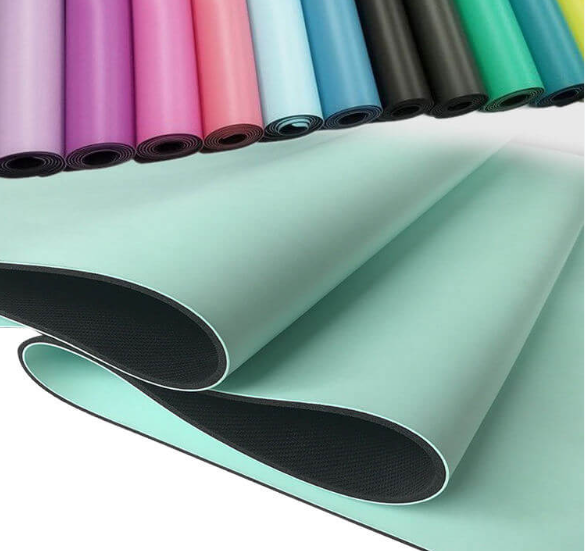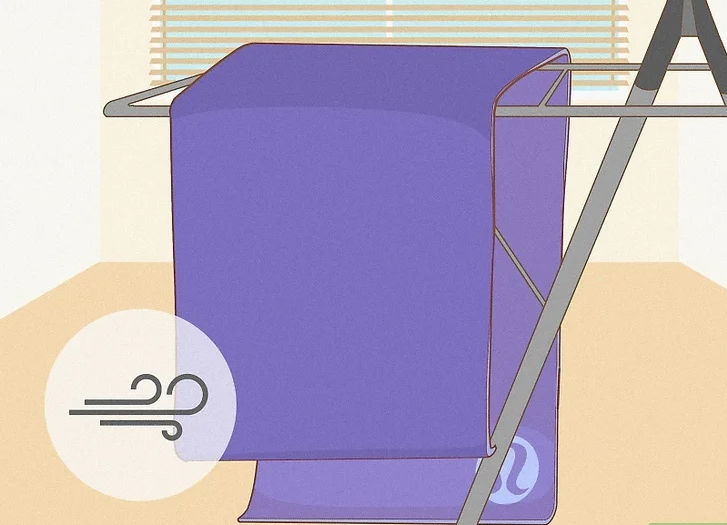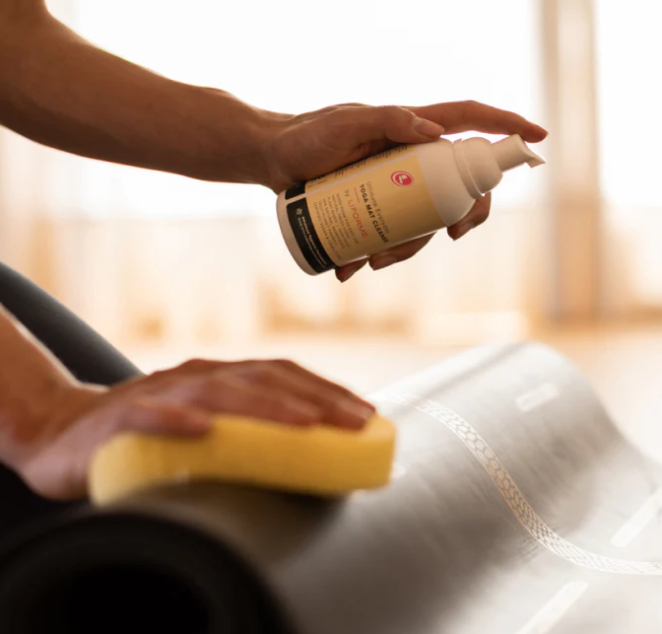I believe cleaning your natural rubber yoga Mat is key. A clean mat lasts longer and helps keep your practice safe. Your mat can gather dirt, sweat, and germs over time. This affects its grip and how well it performs. I recommend using a proper cleaner to protect your mat and keep it hygienic.
Why Cleaning Natural Rubber Yoga Mats is Important
From my experience, natural rubber yoga mats are great for the planet, but they do need special care. Cleaning your mat often makes it last longer. It also improves the surface texture. This helps prevent slips and keeps you safe during your poses.
Importance of Using Gentle, Natural Ingredients
I suggest you pick a cleaner with gentle, natural ingredients to protect the rubber. Harsh chemicals can break down the mat and lower its quality. A mixture of water with natural essential oils or vinegar works well. These ingredients clean your mat and also provide pleasant scents, which can make your practice feel more refreshing.
Recommended Cleaning Methods
- Simple Soap and Water Solution: I like to mix a few drops of mild dish soap into warm water. Use a soft cloth to wipe down your mat, and then rinse it with clean water.
- Vinegar Spray: Mix equal parts water and white vinegar in a spray bottle. Spray a light mist over the mat and wipe it clean with a cloth.
Understanding Natural Rubber Yoga Mats
From my experience, people love natural rubber yoga mats because they are good for the planet and last a long time. These mats are different from ones made of PVC or TPE. I like that natural rubber breaks down naturally and comes from trees, a resource we can renew. This makes it a great choice if you care about living sustainably.

What makes natural rubber different from other materials (PU, PVC, TPE)
I love the feel of natural rubber mats. They have a fantastic grip that prevents slipping while you practice. Here is how they compare to others:
* I find that PU mats, being man-made, don’t offer the same grip or flexibility.
* PVC mats can harm the environment because they don’t decompose.
* TPE mats are very light, but in my opinion, they are not as tough or cushioned as natural rubber.
Why it’s sensitive to oils, heat, and synthetic cleaners
You do need to be careful with your natural rubber mat. I’ve seen that oils and high heat can cause it to break down over time. Using synthetic cleaners is also a bad idea. Harsh chemicals can destroy the rubber, leaving you with a weak surface. I strongly recommend you choose gentle, natural cleaning products. This is the best way to keep your mat in great condition.
Benefits of maintaining a clean surface (grip, hygiene, longevity)
Cleaning your natural rubber yoga mat often improves its grip. This also gets rid of sweat and germs for better hygiene. A clean mat will last a lot longer and keep performing well. I feel that a clean mat leads to a much nicer and safer yoga session. It helps you focus on your practice without being distracted.
What I Recommend You Avoid When Cleaning

To keep your natural rubber yoga mat in good shape, I suggest you avoid certain substances. They can damage the mat’s surface. From my experience, here are a few key items to stay away from:
Alcohol-based Sprays
I’ve learned that alcohol breaks down natural rubber. It will cause cracks and weaken the surface of your mat.
Vinegar
I know vinegar seems like a good natural cleaner. Its acid, however, can wear down the rubber over time. This affects how the mat feels and performs.
Oils or Heavy Essential Oil Mixtures
Using oils or heavy essential oils can make the surface slippery. I feel this is a safety risk. These oils may also cause the mat material to break down. This will ruin both the grip and comfort you need for practice.
By staying away from these items, I believe you can help your mat last longer and work better. This makes sure you have a safe and enjoyable practice.
My DIY Recipe for a Natural Rubber Yoga Mat Cleaner
I find cleaning my natural rubber yoga mat is simple with this DIY cleaner recipe. I suggest using gentle, natural ingredients to keep your mat in great shape.

Ingredients I Use:
- Distilled water
- Mild castile soap or organic dish soap
- (Optional) A few drops of tea tree oil or lavender (in low concentration)
Mixing Directions:
- Ratio: 1 cup distilled water + 1 tsp mild soap + 1–2 drops essential oil
- Shake the mixture well before each use.
How I Apply the Cleaner:
- Spray the mat: Mist the cleaner over the surface of your yoga mat.
- Wipe down: Use a soft cloth to wipe the mat. I focus on areas that gather dirt and sweat.
- Rinse (if you need to): If you picked a soap that requires rinsing, wipe the mat again with a damp cloth.
Based on my experience, this DIY cleaner helps maintain your mat’s grip and performance. It also ensures your mat is hygienic and safe for your practice.
Daily Maintenance Tips to Keep It Clean
After using natural rubber mats for years—both personally and through my work with yoga mat manufacturing—I’ve learned that daily care is the key to keeping them in great shape. It doesn’t have to be complicated. With just a few simple habits, I keep my mat clean, grippy, and ready for the next practice.
Here’s what I personally do after every session:
Wipe My Mat After Every Practice
As soon as I’m done practicing, I take a soft, damp cloth and gently wipe down the surface of my mat. Most of the time, plain water is enough. If I’ve been sweating more than usual, I’ll use a tiny bit of gentle, natural soap in the water. I avoid using paper towels or anything abrasive—they can damage the rubber surface.
Always Let It Air Dry
Once I’ve wiped it down, I hang my mat over a chair or lay it flat in a cool, shaded spot to air dry. Natural rubber doesn’t like moisture, so I make sure it’s completely dry before rolling it up. I never leave it in the sun or use a heater—it can cause the mat to dry out or crack.

Use a Towel During Sweaty Sessions
On hot days or during power yoga, I lay a microfiber yoga towel on top of my mat. It catches sweat and keeps the mat itself clean. After class, I just throw the towel into the wash. This trick helps me reduce how often I need to deep-clean the mat—it’s a lifesaver.
Wash My Hands and Feet First
Before I even step on the mat, I quickly rinse my hands and feet. This removes oil, dirt, and lotion that would otherwise transfer onto the surface. It only takes a minute, but it keeps my mat so much cleaner over time. I’ve also learned to avoid using hand cream or body lotion before practice—rubber mats don’t love oil.
My Tips for a Deep Clean (Do This Once in a While)
I find that deep cleaning your natural rubber yoga mat is important. It helps the mat last longer and stay hygienic. Based on my experience, you should perform a deep clean every 1–2 weeks. If you practice often, you might need to clean it more.
How I Deep Clean My Mat
- Mix the Cleaner: I combine a small amount of mild castile soap with warm water. I use a ratio of about 1 cup of water to 1 teaspoon of soap.
- Use a Soft Sponge: I take a soft sponge and scrub the entire surface of the mat. For tougher spots, I’ll add a bit more soap.
- Rinse it Well: After scrubbing, rinse your mat with clean water. I make sure to wash off all the soap.
- Let it Dry: I let my mat dry flat in a shaded area with good airflow. I avoid direct sunlight, as the sun can damage the rubber.
Why Regular Deep Cleaning Matters
I believe a regular deep clean improves your grip and keeps the mat fresh. The cleaning removes sweat, dirt, and bacteria. This way, your mat stays safe and pleasant to use for your practice.
Checking Your Mat’s Condition
I recommend you keep an eye on your mat for any signs of wear. If it feels less grippy or you see cracks, it might be time for a better clean. It could also mean you need a replacement.
My Tips for a Longer-Lasting Mat
I want to help you make your natural rubber yoga mat last. Proper storage is key. Even a clean mat can get ruined if you don’t store it the right way. Based on my experience, these tips will help keep your mat in great shape.
Find a Cool, Dry Spot
I recommend keeping your mat somewhere cool and dry. Too much humidity or heat will damage the natural rubber. A closet or a shelf is a great choice. Just make sure it is a place where the temperature stays pretty stable.
Keep It Out of the Sun
Never leave your mat in direct sunlight. Leaving it in the sun for too long makes the rubber hard and brittle. When that happens, it loses its grippy feel. I suggest finding a shady spot to protect it from the sun’s rays.
Roll It Gently, Top Side Out
When you put your mat away, give it a gentle roll. Do not roll it too tight. I always roll mine with the top, grippy side facing out. This prevents putting too much pressure on the practice surface. It is a simple trick to help the mat keep its shape and cushion.
Do not Fold or Crease It
Please do not fold your mat. Folding creates permanent marks and can really damage it. I always recommend rolling your mat. This will keep it in the best shape for your next yoga session.
I Suggest a Mat Bag
I personally think a yoga mat bag is a great investment. It protects your mat when you travel and while it is in storage. I recommend finding a bag that lets the mat breathe. This also helps keep it safe from dust and dirt.
I have learned that following these tips makes a big difference. Your natural rubber yoga mat will stay in excellent shape. It will be ready for many more yoga sessions.
summary
Taking care of your natural PU rubber yoga mat doesn’t have to be hard. In my experience, using simple, natural ingredients with a consistent cleaning habit is enough. This practice keeps my mat clean, grippy, and makes it last for years. I believe the effort you put into your mat shows respect for your practice. Stepping onto a clean, well-kept mat helps me feel safer. It also leads to a more focused session that supports my yoga journey.

